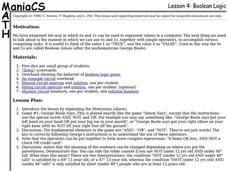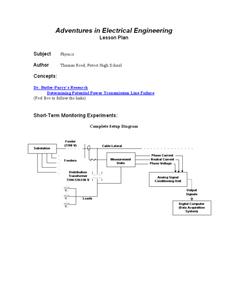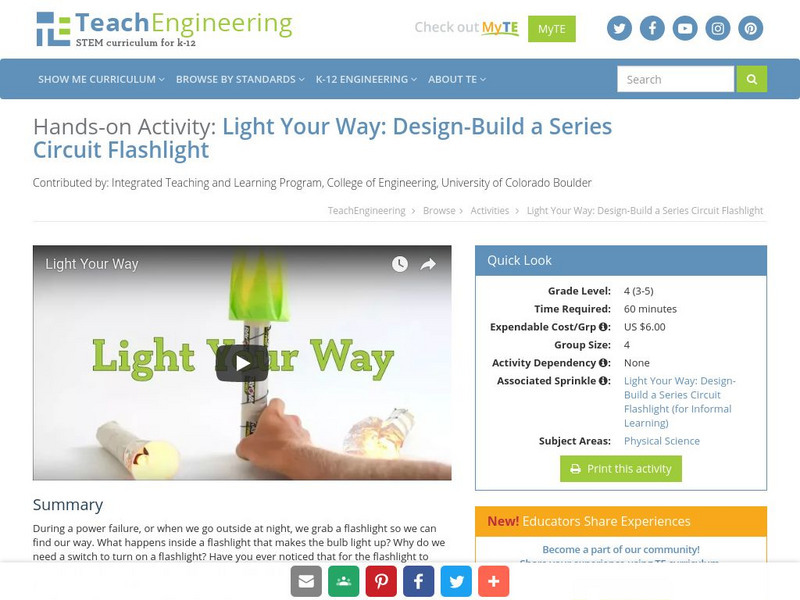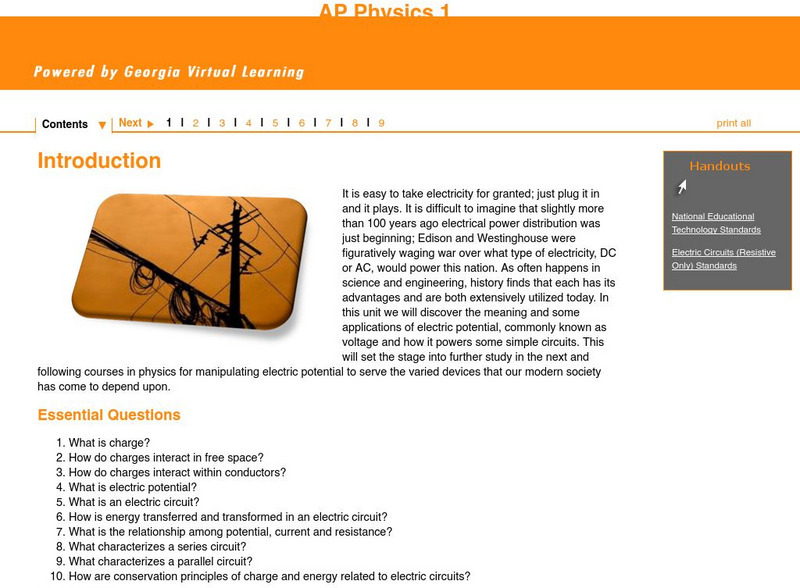Curated OER
Orienting a Photovoltaic Cell
By mounting a light bulb on a stand and a PV cell on another, physics apprentices experiment with the angle of incidence. Their goal is to determine the optimum angle for collecting solar energy. The use of a scientific calculator...
Teach Engineering
Building a Piezoelectric Generator
In pairs, learners build a piezoelectric generator from readily available electric components in the second and final installment of the two-part series. Tapping the piezoelectric element produces enough electricity to light an LED....
Curated OER
Electricity
Students identify the relationship between batteries, circuits and voltage. In this physics lesson, students investigate the way batteries are put into different apparatus. They discuss why different machinery need different voltage of...
Curated OER
OHM's Law
Students study the relationship between current, voltage and resistance in a series circuit. In this investigative lesson students watch a demonstration and see how voltage is measured and see what OHM's law is.
Curated OER
Using electricity
Young scholars explore how a switch can be used to break a circut. Students construct a simple series circuit and use it for a purpose. Young scholars read the "The Lighthouse Keeper's Lunch,or one of the "Katie Morag" stories which...
Curated OER
Boolean Algebra
Pupils play a series of games involving Boolean logic. For this Boolean Algebra lesson, students participate in games such as "George Boole Says" to explore Boolean logic. The format of the lesson is difficult to read.
Curated OER
Adventures in Electrical Engineering
Students explore electricity by conducting a series of experiments. In this physics lesson plan, students discover the relationship between current, voltage and resistance. They calculate voltage and power in a given system.
Curated OER
Water Fitness
Students participate in a series of aerobic exercises in water to help improve fitness.
Curated OER
Electromagnets
Students conduct a series of experiments on electromagnets. For this physics lesson, students build their own electromagnet and explain how it works. They determine the factors that affect its strength.
Curated OER
Physics: Electricity and Magnetism
Pupils draw series and parallel electrical circuits. In this electromagnet lesson, students describe how current changes depend on circuit components. Pupils use an OHT of a series and parallel circuit to predict the path of...
Curated OER
Electricity
Students examine basic electrical components. They build a simple electrical circuit which rings a buzzer. They experiment with conducting and nonconducting materials.
Curated OER
Making an Electromagnet
Students explore electromagnetic forces. In this electromagnetic lesson, students construct a working electromagnet and conduct a series of experiments to see what increases the strength of an electromagnet.
Curated OER
Red Shift, Blue Shift
Middle schoolers demonstrate how stellar spectra measures a star's motion relative to Earth along the line of sight.
Curated OER
Electromagnetism
Students explore the generation of magnetic fields from currents in wires and measure the magnetic field directions. They measure magnetic fields in their own environment. They also examine how moving magnetic fields can create currents.
Curated OER
Telegraph System
In this telegraph system worksheet, students design a telegraph station and answer 4 questions about the voltage, the resistor values and various modifications made to their design.
Curated OER
Lightning Rod
In this lightning rod worksheet, students make a lightning rod out of batteries, breadboard, light bulbs, wires, and more. Students also answer 2 questions.
Curated OER
Making A Compass
This interesting science instructional activity is about the compass. Students make a compass out of a magnet, sewing needle, cork, and a glass dish. The instructional activity includes both a pre and post-test for the students to take,...
Curated OER
Making Energy "trails"
Students explore ten different stations that demonstrate either chemical, kinetic, or mechanical energy. They examine the way energy is transferred during each station's hands-on activity. Stations include vinegar and baking soda,...
TryEngineering
Try Engineering: Series and Parallel Circuits
The core of this lesson is simple circuits and the differences between parallel and series circuit design. Students perform experiments to test the differences between the two circuit designs using low voltage light bulbs.
Science and Mathematics Initiative for Learning Enhancement (SMILE)
Smile: Simple Circuitry and Series Circuit
A teacher lesson plan which could be easily converted into an idea for a student project or presentation. This page describes an activity in which the basic nature of a circuit and the concepts of a series circuit are investigated....
Other
Tech Topics: Electricity: Circuits
What is a circuit? How does it work? The animated diagrams and accompanying text will make it easy to understand the concept of circuits!
TeachEngineering
Teach Engineering: Light Your Way
When there is a power failure, or when we go outside at night, we grab a flashlight so we can find our way. What happens inside a flashlight that makes the bulb light up? Why do we need a switch to turn on a flashlight? Have you ever...
CK-12 Foundation
Ck 12: Physical Science: Series and Parallel Circuits
[Free Registration/Login may be required to access all resource tools.] What series and parallel circuits are and how they differ.
Georgia Department of Education
Ga Virtual Learning: Ap Physics 1: Electric Circuits
In this unit students discover the meaning and some applications of electric potential, commonly known as voltage, and how it powers some simple circuits.























